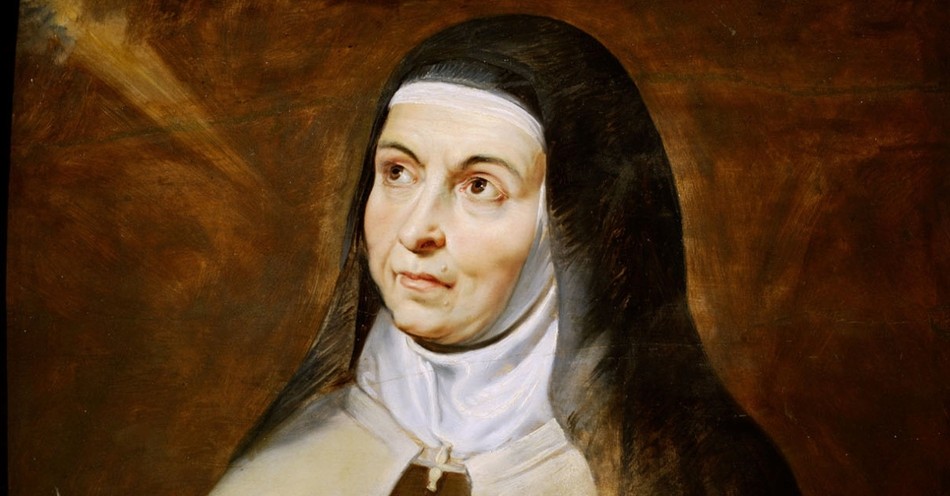St. Teresa of Avila was recognized as the first woman doctor of the church by Pope Paul VI in 1970. At the time, this honor had been given to only 30 saints of the Roman Catholic church. St. Teresa earned this place in the church for her reform work and mystical ideas on mental prayer, inspiring generations of Christians.
She lived during the 16th Century in what is now Spain as a vibrant, sociable soul who did not practice her faith in the “rigid asceticism and self-denial” of her peers. The Protestant Reformation and the Spanish Inquisition outlined her life’s journey. She navigated through a time when a new Christian spirituality was developing, and the Roman Catholic church enforced strict, traditional standards. To restore the Carmelite Order of the Incarnate to its original simplicity and austerity, St. Teresa traveled and spoke her mind in a not traditionally acceptable manner for a woman and a nun. Some critics thought she had Protestant leanings, but she was a devout Roman Catholic. Although she suffered from poor health her entire life and many criticized her mystical beliefs, she remained effervescent in her administrative duties at many convents. However, her greatest legacy is her body of writing that emphasizes the importance of experiencing God’s love while reaching for Him through the practice of “mental prayer.”
10 Important Events in St. Teresa of Avila’s Life
1. When St. Teresa was about five years old, she and her older brother snuck into Moorish territory, hoping to become martyrs for Christ. An uncle brought them back home.
2. Her wealthy, strict, and religious father sent her to a convent school when she was 16.
3. St. Teresa of Avila contracted malaria shortly after becoming a Carmelite nun and suffered with frail health for the remainder of her life.
4. Dissatisfied with the worldliness that had crept into the Carmelite order, St. Teresa founded the convent of St. Joseph in 1562 with the blessing of Pope Paul IV. Between 1567 and 1582, she founded sixteen other convents of Discalced (“unshod” or “shoeless”) Carmelites.
5. In 1574, a court of the Spanish Inquisition sought to judge her experience of visions, but she escaped persecution by hiding.
6. St. Teresa mentored St. John of the Cross as one of the first members of her Discalced Carmelites. He became her closest friend, being another mystic writer persecuted during the Spanish Inquisition.
7. Her mystical writings are classic literature. In 1580 she wrote what many consider her most significant work, The Castillo Interior (The Interior Castle). The book described stages of spiritual evolution leading to full prayer or “mental prayer.”
8. St. Teresa of Avila died at 67 years old on October 4, 1582. A fellow sister describes the hours just before the death of St Teresa: “Thus immersed in prayer, happy and smiling, she went out of this world into eternal life.”
9. St. Teresa was canonized (declared a Roman Catholic church saint) by Pope Gregory XV on March 12, 1622.
10. St. Teresa of Avila is the patroness of Spain with a feast day on October 15. She is also the patron saint of headaches, sickness, and lace makers.
10 Things You Should Know about St Teresa of Avila
1. She was described by a papal nuncio (a representative and ambassador of the pope) as “a restless, disobedient gadabout who has gone about teaching as though she were a professor.”
2. She was born into a prominent, upper-class family of Jewish and Catholic heritage on March 28, 1515, and lived a sheltered early life.
3. As a child, St. Teresa read popular fiction—medieval tales of knighthood and books on fashion and flower gardens.
4. Her mother’s death when St. Teresa was only 14 led her to embrace a deep devotion to the Virgin Mary as a spiritual mother.
5. In her late teenage years, she lost some of her childhood zeal for a pious life and enjoyed a more worldly, popular existence in Avila. Her upper-class social standing made her a local celebrity.
6. The Carmelite order of nuns that St. Teresa joined when she was 20 years old was founded in Palestine, around 1154. The order is devoted to poverty and meditation and claims to have originated with hermits living in the mountains in Biblical times.
7. Two years after St. Teresa became a nun, her health collapsed. She fell into a coma for a few days and was an invalid for three years before regaining use of her legs.
8. During her severe illness, she developed a passion for mental prayer, a spiritual practice in which St. Teresa heard God’s voice, saw visions, and felt her body levitate.
9. After her recovery from a debilitating illness, she stopped praying for 15 years.
10. In 1555, she underwent a religious reawakening and led a reform of the Carmelite order of religious men and women. Despite frail health and administrative difficulties due to a shortage of funds and resources, St. Teresa spent the rest of her life establishing and nurturing 16 convents throughout Spain.
10 Important Quotations from St. Teresa of Avila
1. “The important thing in mental prayer is not to think much but to love much.”
2. “Love is not great delight but desire to please God in everything.”
3. “You know, I no longer govern in the way I used to. Love does everything… I have discovered that things go better in that way.”
4. “We need no wings to go in search of Him but have only to find a place where we can be alone and look upon Him present within us.”
5. “The order of our life must be what He ordains; let us not ask that our will be done, but His.”
6. St. Teresa wrote several volumes of poetry. Among her most famous poems:
God alone is enough.
Let nothing upset you,
let nothing startle you.
All things pass; God
does not change.
Patience wins all it seeks.
Whoever has God lacks nothing:
God alone is enough.
7. “May He, Who has helped me in other more difficult matters, aid me with His grace in this, for I trust in his mercy.”
8. “Nothing can be compared to the great beauty and capabilities of a soul; however keen our intellects may be, they are as unable to comprehend them as to comprehend God, for, as He has told us, He created us in His own image and likeness.”
9. “Believe me, by God’s help we shall advance more in virtue by fixing our mind on the Divinity than by keeping our eyes bent on ourselves, poor creatures of earth that we are.”
10. “For the love of God, keep free from partialities however holy they may be, for even among the brethren they are like poison.”
Why Should We Remember St. Teresa of Avila Today?
St. Teresa of Avila guided Carmelite nuns and priests with discipline, love, and common sense. However, her leadership and teachings did not abide by the Roman Catholic church conventions that were prevalent in her lifetime. Although she underwent many tribulations from within her own body and from outside influencers, she stressed the importance of experiencing God’s love and living a Christian life in a mystical, intimate way.
In an article on St. Teresa titled “God Alone is Enough,” the author says, “Beautiful, talented, outgoing, adaptable, affectionate, courageous, enthusiastic, she was totally human. Like Jesus, she was a mystery of paradoxes: wise, yet practical; intelligent, yet much in tune with her experience; a mystic, yet an energetic reformer. A holy woman, a womanly woman.”
St. Teresa remains an inspiration to women and Christians in our time in many places.

This article is part of our People of Christianity catalog that features the stories, meaning, and significance of well-known people from the Bible and history. Here are some of the most popular articles for knowing important figures in Christianity:
How Did the Apostle Paul Die?
Who are the Nicolaitans in Revelation?
Who Was Deborah in the Bible?
Who Was Moses in the Bible?
King Solomon's Story in the Bible
Who Was Lot's Wife in the Bible?
Who Was Jezebel in the Bible?
Who Was the Prodigal Son?



_639003522088907085.jpg)